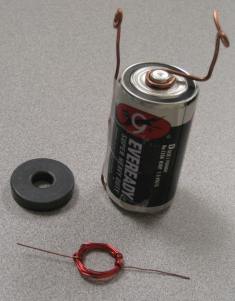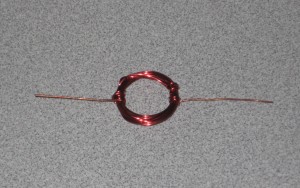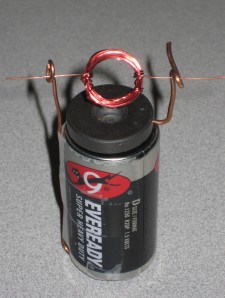Building an Electric Motor
Posted on: June 2, 2008
I do this more as an activity than anything else. I end up trying to cover electricity and magnetism in about two weeks, not anywhere near what is needed. I try to make the material relevant because it’s above most of the students in my conceptual physics classes. This is one of those activities where they amaze themselves.
I got the plans for an electric motor design from the book “Teaching Physics with Toys” by Taylor, Poth, & Portman. This book is really geared towards K-9, but I figure that if I find the activity cool, then why wouldn’t an 11th or 12th grader. I have the 1995 edition, they have a new edition that I haven’t seen. I don’t even know if this activity is in the new edition.
You can find similar activities on the web. (Build It: Electric Motor), but I like the design in the book better. Basically, you need a D cell, a doughnut magnet (available at Radio Shack), some bare heavy wire, like 14 or 16 gauge, some transformer or magnet wire (22-28 gauge), and a piece of sandpaper.
You take an arms length of the transformer wire, leave about 2 inches and wrap the rest around a dowel 5/8″ dowel or a white board marker, then leave another 2 inches at the other side.
As you may be able to see from the picture to the left, the leads are wrapped around the coil to tie it all together. It is important to try to balance the coil so that the leads are along the centerline of the loop. Next, sand the ends of the magnet wire so that the red coating is gone and you can see bare copper.
The magnet goes on top of the battery and will hold the top lead in place. You bring the negative voltage up with a bare copper wire, we use tape to hold the negative lead in place. Make a loop at the top of each with a pair of plyers. Try to make the loops on top at the same height so the motor doesn’t slide sideways.
To start the motor, just put it all together. You usually have to remove the positive lead to fit the winding coil into the loops. Put the leads back on and pop the magnet in place. If its really well made, the motor will begin spinning on its own. That rarely happens. Just give it a light spin. You will need to play with the leads to get them centered, but then when you get it right, it can run for hours.
15 Responses to "Building an Electric Motor"
I did this when I was student teaching with 8th graders. The looks of excitement on their faces when their motor spun on it’s own was priceless.
Our plan was a little different and easier in a middle school environment (i.e. less science supplies on hand, like thick copper wire) We used an upside down disposable cup as the base. Two paper clips for the armatures/leads and mounted the battery sideways on the cup.
Good fun.
Bryan, I am looking for the instructions for the motor you describe. Could you post it or email it to me? D.
I’m having some difficulty with this project, as my teacher requires the 22 gauge wire to move something as it spins.
Do you (or anyone else for that matter) have any suggestions on a way to increase the power, or ideas on what this would work to move?
excellent
This is a great basic experiment that most people will not understand. Taking this one step further, if you were to somehow connect a small fan on the end of the rotating piece, it could be used to create wind. If the device was placed outdoors and the wind speed were greater than what the battery and electromagnetism were to produce, power would actually be put back into the battery and not used from it. This is the same way the large wind turbines work. They actually have to become motors to start up and pace with the wind; when the wind exceeds the value of the energy required to keep the blades turning- power is put back into the electric grid.
[…] but soon switched to this model: https://teachingphysics.wordpress.com/2008/06/02/building-an-electric-motor/ when I knew the non permanent magnet motor was not going to work for […]
Hey There. I found your weblog the use of msn.
That is an extremely neatly written article.
I will make sure to bookmark it and come back to learn more of your useful information.
Thanks for the post. I’ll certainly return.
You have to give a tube radio at least 20 to 30 minutes just to warm up and then you decide what frequency you
want to be on and load the plate and tune them up. Next, build a list of prospects
and develop a relationship with those prospects on your list.
You will need an outside antenna to get clear reception on
your radio.
Superb post however , I was wondering if you
could write a litte more on this subject? I’d be very grateful
if you could elaborate a little bit further. Kudos!
Hey, I think your blog might be having browser
compatibility issues. When I look at your blog site in Chrome,
it looks fine but when opening in Internet Explorer, it has
some overlapping. I just wanted to give you a quick heads
up! Other then that, very good blog!
Great post but I was wondering if you could write a litte
more on this topic? I’d be very grateful if you could elaborate a little bit more.
Kudos!
When I originally commented I clicked the “Notify me when new comments are added” checkbox and now each time
a comment is added I get four emails with the same comment.
Is there any way you can remove me from that service?
Cheers!
The article is very informative about building electric motor. I like this article very much. Thanks for sharing it.




June 2, 2008 at 9:35 pm
Can I expand on your post?
I want to add something about electric motors:
An electric motor uses electrical energy to produce mechanical energy. The reverse process, that of using mechanical energy to produce electrical energy, is accomplished by a generator or dynamo. Traction motors used on locomotives often perform both tasks if the locomotive is equipped with dynamic brakes. Electric motors are found in household appliances such as fans, refrigerators, washing machines, pool pumps, floor vacuums, and fan-forced ovens.
The classic division of electric motors has been that of DC types vs AC types. This is more a de facto convention, rather than a rigid distinction. For example, many classic DC motors run happily on AC power.
The ongoing trend toward electronic control further muddles the distinction, as modern drivers have moved the commutator out of the motor shell. For this new breed of motor, driver circuits are relied upon to generate sinusoidal AC drive currents, or some approximation of. The two best examples are: the brushless DC motor, and the stepping motor, both being polyphase AC motors requiring external electronic control.
There is a clearer distinction between a synchronous motor and asynchronous types. In the synchronous types, the rotor rotates in synchrony with the oscillating field or current (eg. permanent magnet motors). In contrast, an asynchronous motor is designed to slip; the most ubiquitous example being the common AC induction motor which must slip in order to generate torque.
October 27, 2012 at 1:16 am
thanku fr ur building an electrical motors . I will try to design this as practicaly.